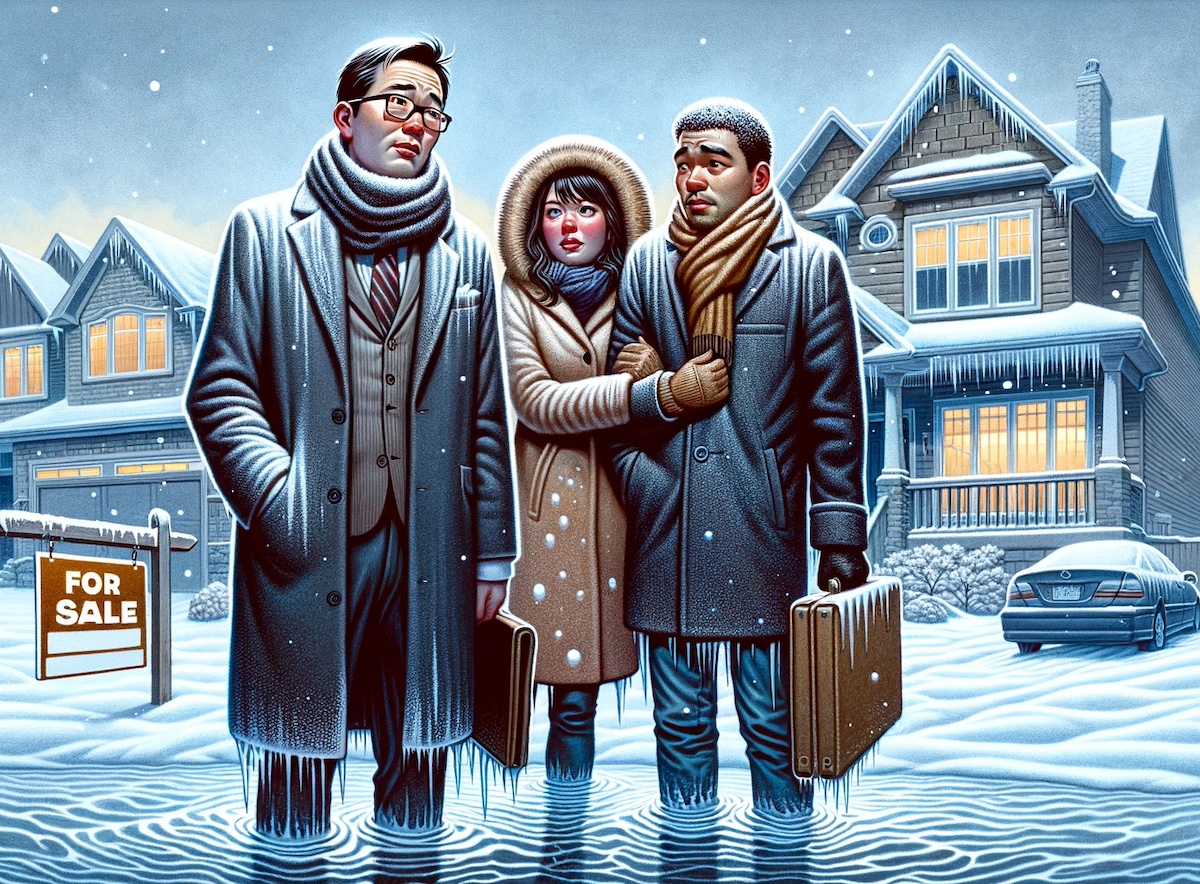In the heart of a frozen real estate landscape, homebuyers and sellers grapple with a paradoxical market.
Amidst the bustling energy of American life, a peculiar stillness has descended upon the real estate market. It’s a freeze unlike any witnessed in the past four decades, marked by record-low home listings and a sharp decline in housing affordability. This frigid climate in the housing sector raises intriguing questions and offers a unique window into the complexities of market economics, demographic shifts, and the American dream of homeownership, according to finance professor Patrick Boyle. Good news appears as lower interest rates begin a thaw.
The Affordability Avalanche
In 2021, the American dream seemed within reach for many. A buyer with a modest $2,500 monthly budget could aspire to a $758,000 home. Fast forward to today, and that same budget barely stretches to a $424,000 residence. The cause? A tempest of soaring interest rates. It’s a stark change that defies expectations. Common wisdom suggests that as affordability plummets, so should prices. Yet, U.S. house prices teeter near their zenith, challenging conventional market theories.
Redfin’s insights reveal a staggering reality: the income required to afford a median-priced home has leaped from $45,000 in 2012 to $115,000 today, assuming one adheres to the prudent rule of spending no more than 30% of income on housing. How, then, do we reconcile these high house prices with the Everest-like peaks of borrowing costs?
The Standoff: High Prices in a High-Interest Era
Sam Khater, Freddie Mac’s chief economist, sheds light on this paradox. The low inventory of houses, he asserts, has bolstered prices, leading to a peculiar standoff. Buyers and sellers alike are playing a waiting game, hoping for more favorable conditions.
Sales of existing homes have plunged by over 15% in the last year, reaching their lowest in a decade. Economists from Wells Fargo to Morgan Stanley paint a grim picture, warning of a housing recession reminiscent of the 1980s. Yet, despite these dire predictions, house prices remain stubbornly high.
The Ripple Effect: A Market in Deep Freeze
The impact of this frozen market extends beyond buyers and sellers. Homebuilders, traditionally buoyed by a robust market, face dwindling confidence. This, in turn, has led to a decrease in construction and a consequential drop in employment opportunities for tradespeople. Real estate agents, too, feel the pinch as their earnings falter amidst stagnant sales.
Companies like Restoration Hardware attribute their recent financial struggles to this market freeze, foreseeing a need for increased discounting strategies. The broader economic implications are clear: when people aren’t moving, the ancillary spending that usually accompanies home purchases—like furniture and home improvements—also freezes over.
The Mystery of Resilient House Prices
But why, amidst these chilling conditions, do house prices refuse to fall? The answer lies in a combination of factors:
- Mortgage Rate Lock-In Effect: Many homeowners have secured low-interest rates from the pandemic era and are reluctant to move, fearing higher rates on new mortgages.
- Demographic Shifts: The aging population, particularly Baby Boomers, are more inclined to ‘age in place’, further reducing housing supply.
- Construction Constraints: Post-Global Financial Crisis, the construction of new homes has lagged behind household formation, exacerbating supply issues.
- Economic Policies: Unique to the U.S., the 30-year fixed-rate mortgage offers stability to homeowners, but also disincentivizes mobility in a rising interest rate environment.
Comparisons and Contrasts: Then and Now
Looking back to the prelude of the 2007-2008 Global Financial Crisis, today’s landscape is markedly different. Lending standards have tightened, and the majority of mortgages are now the less risky 30-year fixed variety. Credit scores, loan-to-value ratios, and debt-to-income ratios all point to a lower risk profile for today’s borrowers.
Thawing the Market: Pathways to Equilibrium
For the real estate market to regain its fluidity, affordability must be restored. This could occur through a reduction in house prices, a fall in interest rates, or an increase in disposable income. History suggests that market corrections can take years, leaving many to wonder how long this current freeze will last.
As we navigate these icy realms, the stories of those in the thick of buying or selling offer a human dimension to the data. Are you braving this frozen market? Share your experiences in the comments below, and let’s journey through this unprecedented landscape together.
Some heartwarming news! Anyone considering buying a home in the next 30-90 days… or if you bought earlier this year at a 7-8% rate and want to refinance – one of our preferred mortgage brokers just locked in 2 buyer clients of ours at a 5.4% rate and a 5.2% rate. These are superrrrr low And continuing to go down. Shoot me a text at 213-880-9910 and will get you more info. They’re #1 for a reason!
Get a free list of low rate lenders. Fill out the online form.
LOFT & CONDO LISTINGS DOWNTOWN LA [MAP]SEARCH LOFTS FOR SALE Affordable | Popular | Luxury
Browse by Building | Neighborhood | Size | Bedrooms | Pets | Parking

Copyright © This free information provided courtesy Entar.com with information provided by Corey Chambers, Broker DRE 01889449. We are not associated with the seller, homeowner’s association or developer. For more information, contact 888-240-2500 or visit WeSellCal.com Licensed in California. All information provided is deemed reliable but is not guaranteed and should be independently verified. Text and photos created or modified by artificial intelligence. Properties subject to prior sale or rental. This is not a solicitation if buyer or seller is already under contract with another broker.











